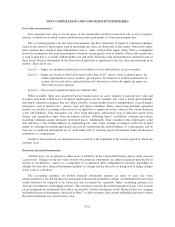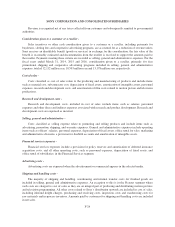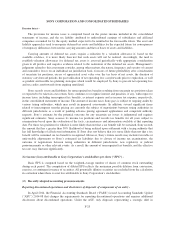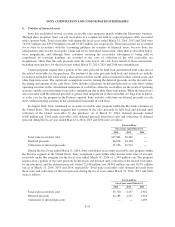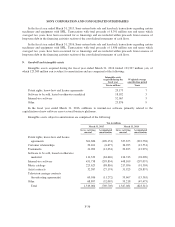Sony 2015 Annual Report Download - page 160
Download and view the complete annual report
Please find page 160 of the 2015 Sony annual report below. You can navigate through the pages in the report by either clicking on the pages listed below, or by using the keyword search tool below to find specific information within the annual report.SONY CORPORATION AND CONSOLIDATED SUBSIDIARIES
operations that has, or will have, a major effect on the entity’s operations and financial results should be
presented as discontinued operations. Additionally, the ASU requires additional disclosures for discontinued
operations as well as for disposals of significant components of an entity that do not qualify for discontinued
operations presentation. This ASU is effective for Sony as of April 1, 2015. The effect of this ASU did not have a
material impact on Sony’s results of operations and financial position.
(3) Recent accounting pronouncements not yet adopted
Revenue from contracts with customers -
In May 2014, the FASB issued ASU 2014-09 addressing revenue recognition which will supersede the
current revenue recognition requirements, including most industry-specific guidance. The guidance requires an
entity to recognize revenue when it transfers promised goods or services to customers in an amount that reflects
the consideration which the entity expects to be entitled to in exchange for those goods or services. In August
2015, the FASB issued ASU 2015-14, which defers the effective date of ASU 2014-09 for one year and permits
early adoption as of the original effective date of ASU 2014-09. This guidance will be effective for the first
quarter of Sony’s fiscal year beginning April 1, 2018 (with early adoption permitted for the first quarter of the
fiscal year beginning April 1, 2017). The guidance may be applied retrospectively to each prior period presented
or retrospectively with the cumulative effect recognized as of the date of adoption. Sony is currently evaluating
the transition method, the timing of its adoption and the impact this ASU will have on Sony’s results of
operations and financial position.
Amendments to the consolidation analysis -
In February 2015, the FASB issued ASU 2015-02 that changes how companies evaluate entities for
consolidation. The changes primarily relate to (i) the identification of variable interests related to fees paid to
decision makers or service providers, (ii) how entities determine whether limited partnerships or similar entities
are variable interest entities, (iii) how related parties and de facto agents are considered in the primary
beneficiary determination, and (iv) the elimination of the presumption that a general partner controls a limited
partnership. This ASU is effective for Sony as of April 1, 2016. The adoption of this ASU is not expected to have
a material impact on Sony’s results of operations and financial position.
Customer’s accounting for fees paid in a cloud computing arrangement -
In April 2015, the FASB issued ASU 2015-05 for fees paid in a cloud computing arrangement. The ASU
requires entities to account for a cloud computing arrangement that includes a software license element in a
manner consistent with the acquisition of other software licenses. A cloud computing arrangement without a
software license element is to be accounted for as a service contract. This ASU does not affect the accounting for
service contracts by a customer. This ASU is effective for Sony as of April 1, 2016. The adoption of this ASU is
not expected to have a material impact on Sony’s results of operations and financial position.
Disclosures for short-duration insurance contracts -
In May 2015, the FASB issued ASU 2015-09 for disclosures relating to short-duration insurance contracts.
This ASU requires additional information to be disclosed related to the liability for unpaid claims and claim
adjustment expenses and significant changes in methodologies and assumptions used for annual reporting
periods. This ASU is effective for Sony as of April 1, 2016. Since this ASU will only impact disclosures, the
adoption will have no impact on Sony’s results of operations and financial position.
Balance sheet classification of deferred taxes -
In November 2015, the FASB issued ASU 2015-17 amending the presentation of deferred income taxes and
requiring that all deferred tax liabilities and assets be classified as noncurrent on the balance sheet. This ASU
F-26







